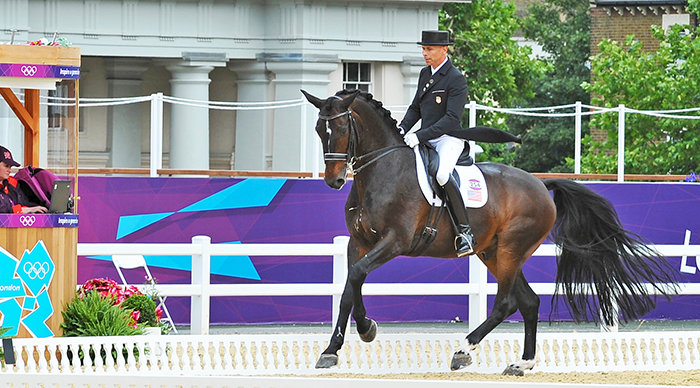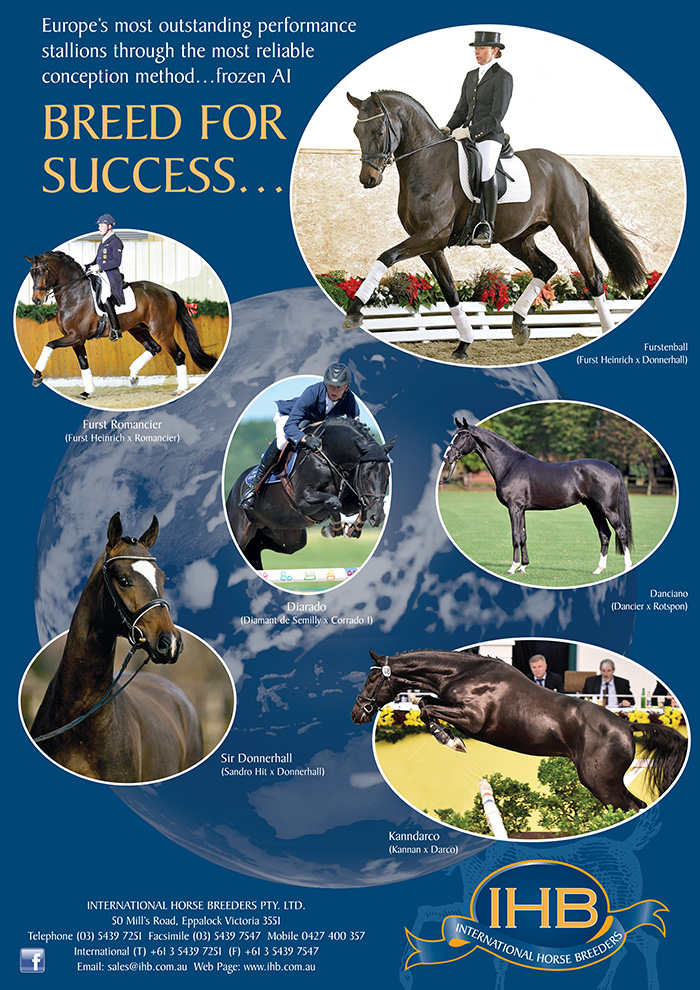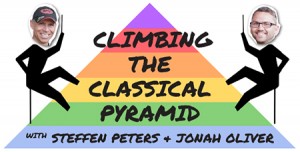The Ultimate Masterclass: Part 5
STORY – KAREN HOSIE PIX – TRICIA OSBORNE & JENNIFER HUBBARD
Welcome back to part five of the seven part series covering the three day Ultimate Master Class with Olympic rider and trainer, Steffen Peters and sports psychologist Jonah Oliver.
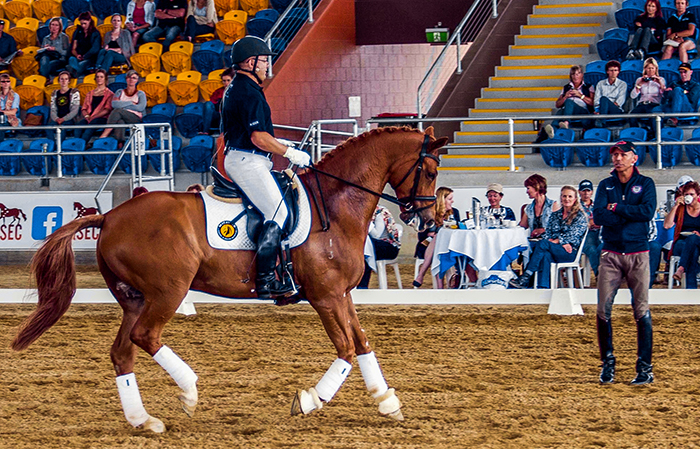
In part 4 we profiled Lientje Schuler riding Ian and Diane Brown’s mare Jaybee Rayana (Lizzie) who is currently trained by Nicole Magoffin; Lientje (pronounced Lyn-cha) as you may remember, is Steffen Peters’s assistant trainer. Whilst working through the forth step of the classical training pyramid; Impulsion- Increased energy and thrust, Steffen and Lientje demonstrated how they work together when training at Steffen’s barn, Aroyo Del Mar in San Diego. Jonah discussed some of the key points that separate riders with a professional mind set from that of the amateur.
The take home points from this training session were that impulsion is not simply increased energy and forward, rather thrust (propulsive power and lift) from the hind quarters. Developing an emotional detachment from the challenges encountered in training will greatly facilitate successful, and often creative, solutions. These challenges are actually significant training opportunities and should be viewed as positive learning experiences.
The Classical Dressage Training Pyramid
Step Five: Straightness -Improved Alignment and Balance
Straightness (Geraderichten) focuses on the horse’s longitudinal axis, when the horse is travelling straight, his hind feet will track in the hoof prints of his front feet whether travelling in a straight line or on the circle.
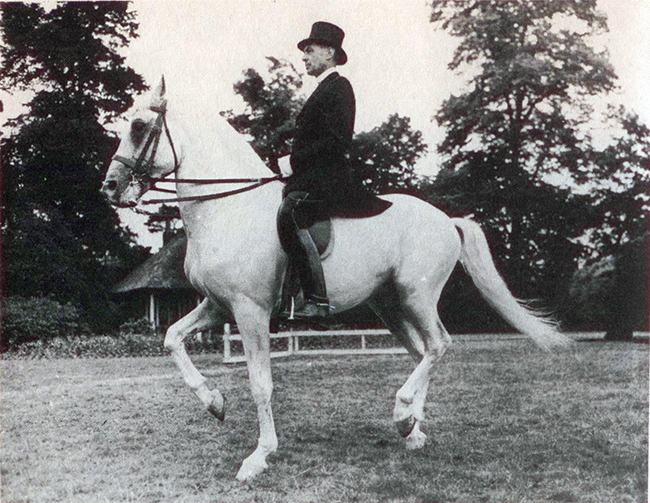
“The importance of straightness is emphasised in one of the most fundamental rules of equitation: Straighten your horse and ride him forward.” – Alois Podhajsky
Straightness is essential for the horse to become properly balanced and carry his weight equally on both sides. The straight horse can optimise his forward thrust or impulsion because he can propel himself forward equally and effectively with his hind legs. It is important to note at this stage that the classical training scale is inter-active, although each level builds upon the success of the level below, the lower levels of rhythm, relaxation and connection will be further enhanced by the completion of higher level work such as impulsion, straightness and collection. Thus the straighter your horse, the more relaxed, balanced and rhythmic it will be. The more relaxed and rhythmic, the more effective your connection and the more effective your connection, the straighter you can ride your horse. Collection of your horse is only possible if he is straight
Young green horses tend to be basically well balanced and straight where the hind feet follow the track of the forefeet. However complete straightness is very rare and under the weight of a rider, most horses tend become crocked; the hind feet are no longer following the tracks of the forefeet but stepping to the side and the contact is no longer even on both sides. Quite often the cause of crookedness in the horse is a crooked rider; if you experience any major difficulties achieving straightness in your horse, check your posture and balance first, as a crocked rider cannot straighten a crooked horse.
Okay all well and good but why is it so important, beyond sounding fairly reasonable, to straighten your horse? If the horse is not stepping into the line of tracks made by the forelegs, he can evade the action of correct bending of the three joints in his hind legs, losing the gymnastic spring and propulsion or thrust that we discussed in the last episode. A further complication is that the horse’s shoulders are narrower than its hind quarters. If you school in an enclosed arena your horse may well swing his hindquarters in and away from the fence or wall whereas the horse’s spine should run parallel to the sides of the arena. Always straighten the horse by bringing the forehand in front of the hindquarters. Never straighten the horse by pushing his hindquarters over behind his shoulders.
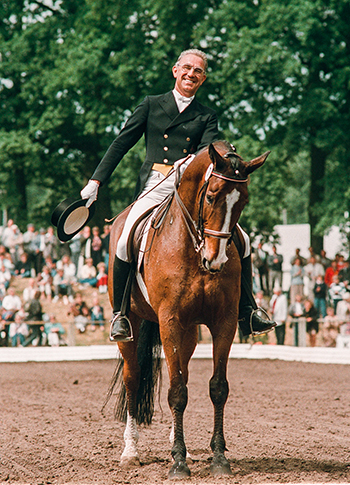
“In our experience natural crookedness is eliminated only by systematic schooling using serpentines, lengthening the stride on the open section of the circle and riding figures of eight to improve suppleness on both sides of the horse. When we are training our horses they respond best with the following principles; we drive with the inside aids into the outside supporting aids on a circle and on all curved lines. For example, in working trot on a circle left, the left (inside) leg drives the horse into the quietly supportive outside rein, so the horse takes the contact and therefore softens to the inside rein. The horse often snorts when he is loosened and softened this way… The horse will gradually become straighter on the left rein once we achieve a contact with the right (outside) rein. The same goes on the right rein for when the left rein is the outside rein. A softly giving inside rein ensures a contact with the outside rein, enabling the horse to be ridden forwards.”
Ingrid & Reiner Klimke, Basic Training of the Young Horse
Story continues below the advertisement
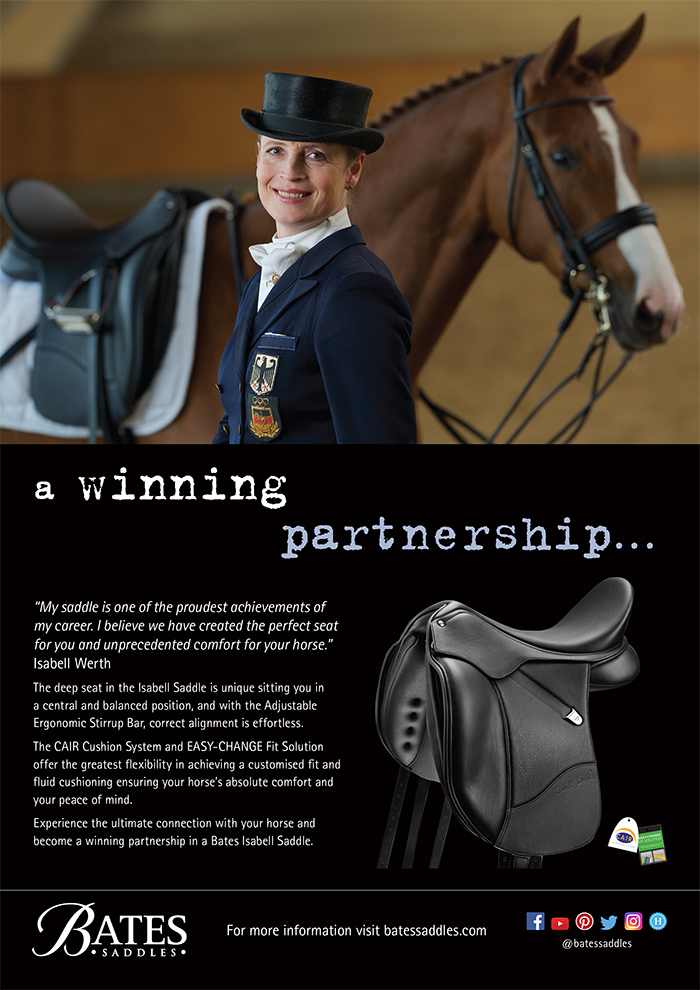
Rider No. 5 Gary Lung riding WB Winchester.
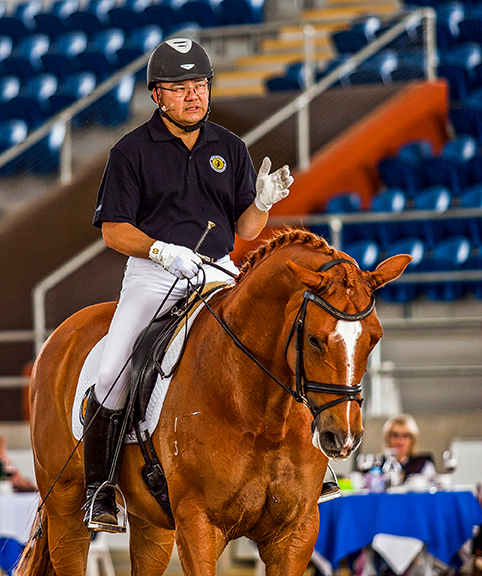
The fifth horse and rider combination is Gary Lung and GB Winchester (Chester) his rising nine year old Hanovarian/Trakehner gelding by Weltmeyer/Elfenglanz and bred by Glennis Barrey, Garry’s long time coach and mentor, out of her Grand Prix mare GB Saffron. To date Chester has the distinction of being the only horse to place at all age levels in the Sydney CDI Young Horse classes; Gary is currently training him at Prix St George level.
Gary combines a city-and-suit career as Training and Development Manager with owning and running Windhill Dressage Stables, an agistment centre and training facility. He has been training with Nicole Magoffin and Lientje Schuler for the past eighteen months. Having attended coaching sessions with several European trainers, including an Andreas Helgstrand Masterclass at Equitana, I asked Gary why he was particularly interested in training with Steffen and what he thought he might gain from the experience.
“Steffen trains along the classical lines. You never see him kick and pull his horses into a frame. He will correct a horse but never punish a horse. I love the way he rides his horses with a soft and effective seat and kind hands yet he can get them dancing at the lightest touch. He certainly looks like he works with the horse and I would love to ride like him. I’ve been working with Lientje for over a year and I love the way she trains. She, of course, has learnt this from Steffen and I’m looking forward to seeing what tools and skills Steffen will provide for my little tool box. It would be fantastic to see Steffen riding Chester and to see how he achieves the goals I’ve outlined.”
Story continues below the advertisement
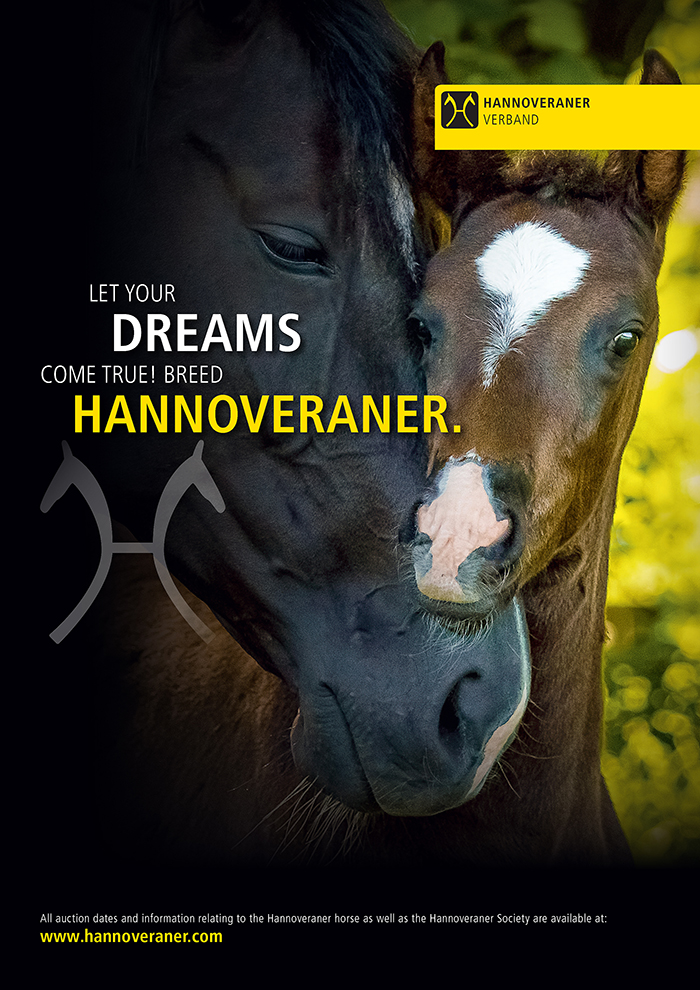
When Gary entered the arena Steffen asked him to trot large and explain any current training issues that they could work on in the session ahead.
Gary: “I really want to work on Chester’s straightness by developing a better connection. Chester is so supple that keeping him together and connected (between the front and the back) is always tricky, as a friend of mine said it’s like riding a marlin. Also developing Chester’s strength in the collected work; he has no issues in doing the movements, he needs to build the strength to carry and sit on his hind quarters while maintaining the quality of the paces.”
Steffen: “Gary I can see that you are riding him in quite a long frame – I would prefer to see him shorter at this stage. I like that you are riding in different tempos which is great, but I also see that when you push him forward he tends to be too loose.”
Gary: “He feels a bit wiggly.”
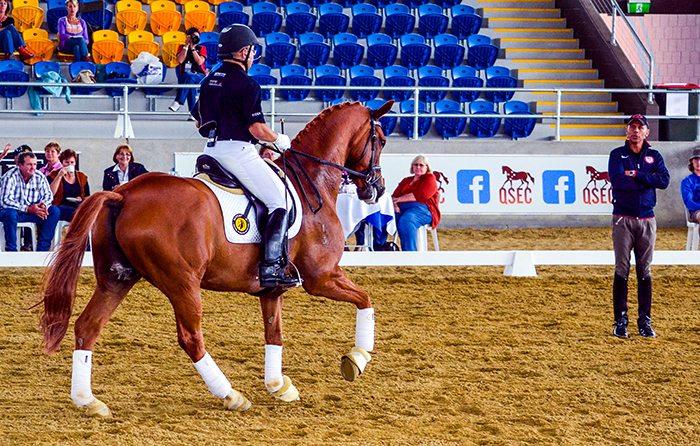
Gary spent the next ten minutes working with Steffen trying to connect the two halves of this very willing, but elastic horse. When Gary pushes him forward he gets longer and loose, then when Gary attempts to collect him back, he pops out somewhere, or fishtails. It’s like driving a high performance rear wheel drive and experiencing oversteer. Gary asks if Steffen would ride Chester and demonstrate how he could be more effective in collecting him and keeping him straight.
Steffen (now riding Chester): “Okay what I would like to see that you shorten him up on the downward transition or half halt and ask him to step more under himself, increasing the connection. Use your whip to tap him on the top of the croup as you use your half-halt, I do this with my horse to tell them to step further under with their hind legs.”
Miraculously – (Although what could we expect) this works. Chester comes together like two pieces of a puzzle; it’s like the horse has suddenly has increased his torque when you change down a gear.
Steffen: “Shorten up your distance; again I would not keep him so long in the safe tempo there. Constantly say look buddy you can go forward but better come back to me just as easily. It’s finding the perfect balance between the gas pedal and the brake pedal. It is so easy for the judges and the trainers to say well you have to go more forward, the question is, can I control it?
Gary: “I agree Chester has a tendency to take over, he says hey I want to do this and I don’t think I am definite enough about exactly when I want to let him and when I don’t.”
Steffen: “Yes, you need raise your expectations and be a bit firmer with the half halt, I have a wonderful memory of a judge in the United States that we lost way too early and he always used to say in the extensions ‘you got to go like hell, but you have to come back from hell too’ and that can be pretty difficult.”
“For most horses they seem to understand the higher degree of collection in canter, testing the collection again, not just driving him into the collection. Okay he took over just a bit and lost the straightness a touch”.
Steffen is now happily riding Chester, testing the connection and his ability to respond to various aids and stay together, front and back operating as one…
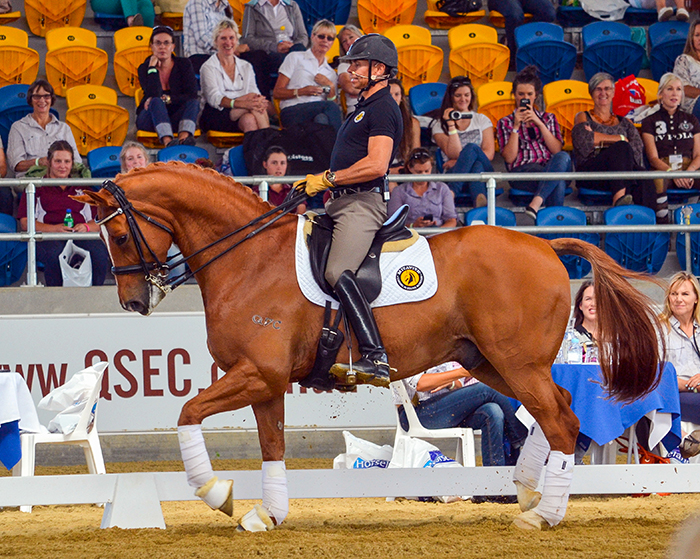
Steffen: “Okay the connection feels good so I want to play a little bit with the pirouettes. Not just to do pirouettes but to get him a little bit more on the hind leg and he is responding against my legs so I don’t want to make the pirouette too small yet.”
Steffen: “Now I feel I have a bit more control so I simply allow him to do the pirouette a bit smaller but I’m not pushing him into a smaller pirouette. I’m allowing him to go forward, and again not making the mistake of staying in the same tempo, collecting him for a few strides and then letting him go out.”
Steffen: “This is working beautifully, this is how it should be, not constantly pushing and driving the horse forward but when I close my leg gently and give the rein allowing him to. So hats off to you Gary you done a good job with him, he is responsive but light.”
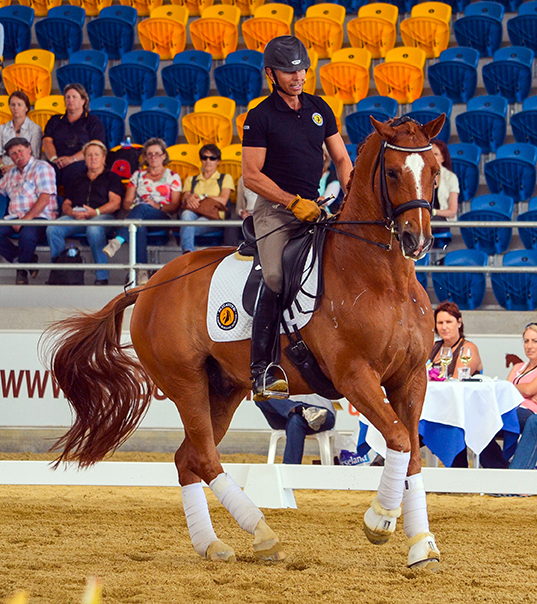
Steffen: “I give him a little bit of rein aid, although my hands are still, there is also a little bit of playfulness in the rein. Good enough. We should test the trot again and let’s check that we have the same response to the half halts we have in canter in trot.”
Steffen: “Again I don’t give the aid once very firmly, more that it is firm but over three steps, one two three, there and he responds with a smooth connection, good boy and down to the halt. This is good, I like it that he does stand still even though he has this much energy. He is relaxed while he is standing. Okay so trotting on, I would like to test the piaffe.
Gary: (working the audience) “Oh wow – can someone take photo, we’ll just photo shop it, I can look that slim on a horse too, I look that good, I sit like that – yeah right.”
Steffen is now laughing as well! “I like to test this at the end of my warm up, I come down the centre line and halt at X – I always ask is my horse still with me? I like his spring and now when I go forward he stays very respectful, okay I’m pretty happy with that – good job.” And Steffen gives Chester a big pat.
Steffen: “Ok Gary now it’s your turn”.
Gary: “Oh Hell – I’ve just pulled a back muscle – I think you will need to keep riding him.”
Steffen: “ I tell you Gary, when I saw him at first, he looked a little bit long and looked a lot more complicated. It usually takes me a lot longer to get where I ended up today, so honestly…”
Gary however has now gone to put up his stirrups after Steffen has been riding, as he views the endless length of leather he has to run them up, he turns to the audience and mimes a look of shock and horror “I feel like a kid, oh my god eight holes” – lots of laughter from the audience.
Steffen: “I was just in the middle of paying you a compliment by the way, just to let you know, but I can see that you are very concerned about the stirrups (more laughter) but joking aside this is good. I really like the feeling and I think he is a wonderful horse and I think we are in really good shape with him. The bottom line Gary is that this is really fun, he loves to work and he loves to offer the movement and you seem to have fun.”
Gary: “I feel like I’ve died and gone to heaven”.
Steffen: “Ha…very good, but what I like so much about horses like this one is that on the one hand they are competitive, because the quality is there, but they are also wonderful teachers. We see so many times horses that are either/or and it is really a great thing to see both qualities in a single horse.”
Story continues below the advertisement
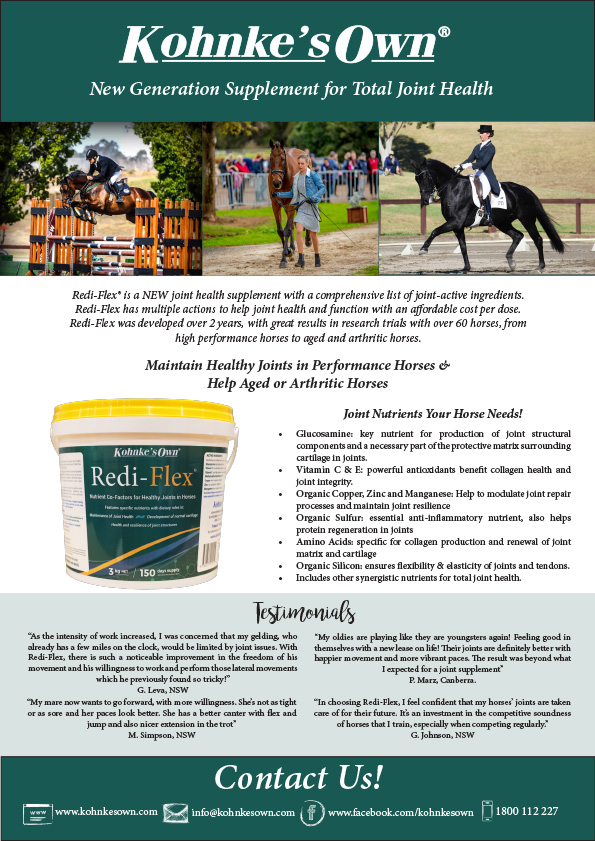
Jonah and Steffen on Mental Focus
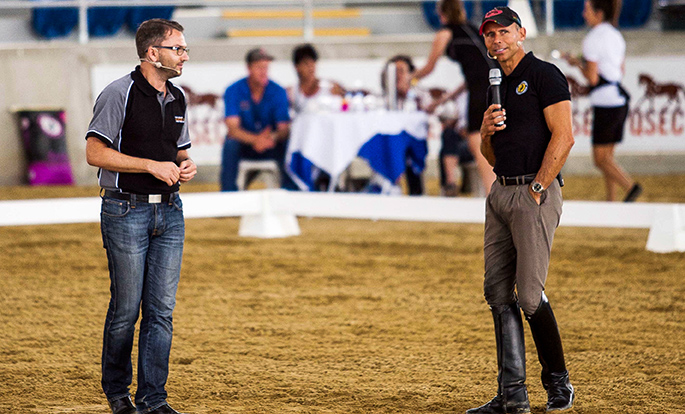
I knew Gary had worked with Jonah Oliver in the past, and was curious as to what he hoped to gain at the Masterclass…
Gary you work professionally as a Training and Development Manager, so you are used to helping people deal with difficult situations, become more effective interpersonal communicators and understand their own motivations better; in what area do you believe Jonah can help you most?
Gary: ”As you say, I have worked with Jonah before, but in my capacity as a training manager and never in an equestrian situation, where I’m actually on a horse and it will be beneficial for Jonah to see me under those conditions. I love the common sense approach that Jonah follows. He does not talk another language but provides you with ‘mind preparation’ and ‘in the moment’ skills that work for you and your horse. I love the way he understands what an athlete experiences. I know I have suffered from competition and pressures in the past and to work with Jonah under these conditions will give me more and more confidence.”
Jonah: “Gary what are your main concerns about preparing for riding in the competition arena?”
Gary: “Once I qualified to be on the State Squad, the increased pressure I felt to maintain and stay there, was really hard to manage, although it’s a pressure I put on myself. I tended to panic if I wasn’t competing or getting great marks. I’d look at my fellow colleagues and other State Squad members who are coming up the ranks, getting good scores, while I’m still pottering around and it wears on the nerves. Then I start to feel the panic that I should be up there and I think, having spent some time working with you in the past, that I realise it is not about matching everyone else measure for measure. It’s your journey and it’s a long journey, so at the end of the day you want a sound horse in body and mind, but probably more importantly a sound Gary.”
General laughter from the audience, but looking about I can see a lot of nodding in personal agreement with Gary’s fears and anxiety.
Jonah: “I couldn’t agree more and I think the main work for you is simply staying in control of what you can control; we call it controlling the controllable. Not getting too caught up in the extraneous stuff; somebody just rode great test, where do I stand in the rankings? The mind then starts to churn and worry and when you ride the test and a movement doesn’t go quite right, that additional, subliminal panic starts to escalate. So I think the real focus is not getting to that hyped stage of panic. Gary what do you do at the moment to recognise and control those panicky feeling rising up?”
Gary: “I feel as soon as I go to competitions I look at the classes and then I think ok Chester let’s step it up, and I’ve learnt that you can’t look at what’s out there.”
Jonah :“Yes, but the problem is you DO look at what’s out there, we all do, it’s just trying not to get too caught up it.”
Gary: “That’s true. I guess what I mean is that instead of focusing on who you are competing against and who you are following, I’m learning to concentrate on choosing a particular event for a reason, to school a certain movement or test the level of accomplishment of a particular training strategy. This has taken me a little while to get used to and I think I would be lying to you if I said I was totally onto of it. The other side of it is that I can get a bit too blasé and say ‘oh it’s just a training event’, so I arrive really relaxed and laid back and then I don’t have the edge. I come out the arena and think ‘where are you’? So I am really hoping to find the happy balance between keeping the adrenaline flowing, keeping the focus but staying calm.”
Jonah: “Well I think everyone in the audience will certainly be able to relate to this, no matter what their level of riding, and I think it really helps that someone at your level, with all your training experience still feels these feelings and that you are prepared to share them with the crowd. Getting so worked up that it impairs your performance, then beating yourself up for it so much so that the next time you compete you are so determined to be calm, you dumb it down ‘it’s just a training run, the results don’t matter’. This is the lie we tell ourselves in the hope that we will remain calm and ride better. But we don’t, we lose focus, minimise our expectations, lower the bar and are then frustrated when we perform accordingly. Steffen you were generous enough during the lunch break to share some of your thoughts on exactly how you deal with these issues with me and I wonder if you would be prepared to come and discuss them with the audience?”
Steffen: “Jonah I would be glad to, one of the reasons I so much enjoy teaching is that I can share and hopefully encourage other riders. I would like to use an interesting example that just happened at the Olympic Games in London. It was during the Grand Prix Special and I came down the centre line, some people here may have seen it, and I started my right pirouette, the pirouette was really good and I went into the one tempis and Ravel stumbled. Now I’m already pretty far down the centre line and I still need to make my nine one tempis and another pirouette right in front of the judges at C. I still can’t quite explain it but I was not in a state of panic. I said to myself ‘ok let’s take three strides, let’s reorganise and start the one tempis again’ and he did nine perfect one tempis and a perfect pirouette. I guess what I want to explain is that it is so, so important to deal, in the training environment, with what could happen in the show arena and you know exactly what to do if a mistake like that happens. It’s about being prepared, for so many wonderful riders, if something goes wrong in the beginning of the test, they still perform and put that mistake aside and I think that really defines professionalism in athletes.”
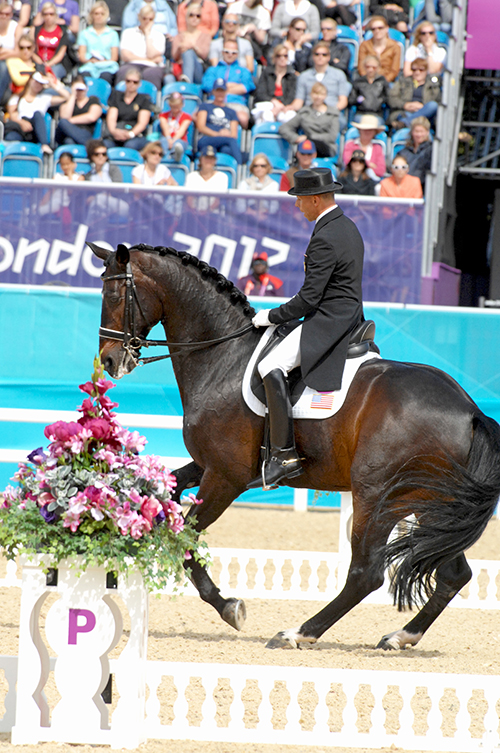
Jonah: “I saw this with the water polo team I was training for the Olympics. One of the first things I said to them was ‘I don’t see you guys training for overcoming mistakes’ this is what I call adversity training. So I instigated a ‘chaos call’ where we would deliberately add a chaos factor to the system, make a random call, kick a player off. The training was so routine and structured that I would deliberately introduce chaos to train the athletes to solve the problem. Most athletes can perform well when things are going right, great athletes perform well when things are going wrong. So I want you to actively think when you are training about constantly solving your problems and not just saying ‘we had a bad day today, tomorrow will be better’ or hitting the panic button and freezing. The more you do it, the easier it will become. So Gary when was the last time you rode a perfect test?”
Gary: “Ahrr… that would be never.”
Story continues below the advertisement
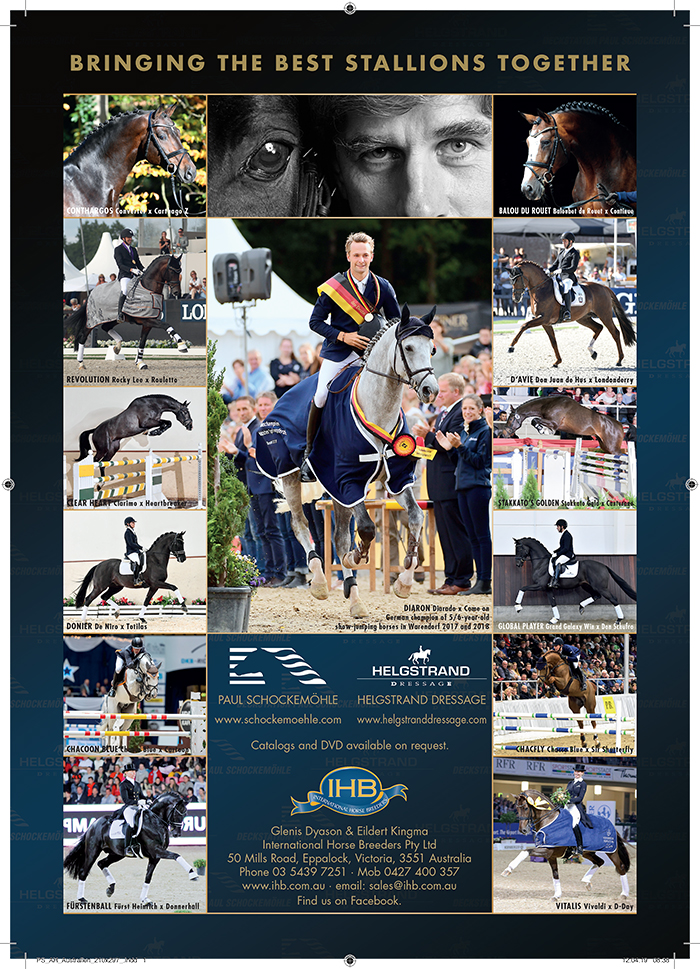
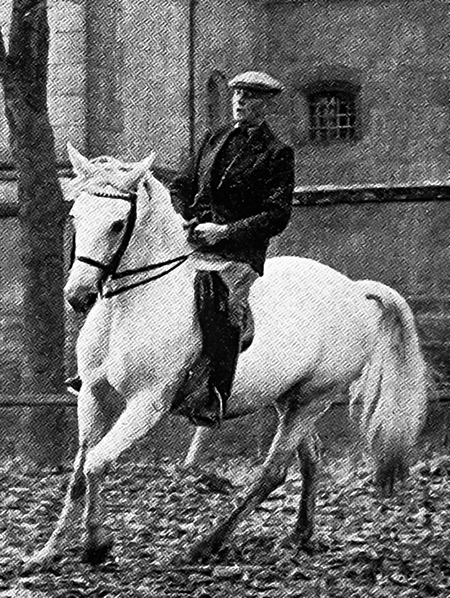
“Let us repeat that the two groups of muscles lying on either side of the spinal column which pulsate elastically rather than convulsively must work quite uniformly along a straight line and on a single track. If they do not do so, the horse becomes crooked, with its legs not carrying an equal load on both sides, and we get the impure gait in all its variants.”
Waldemar Seunig
Jonah: “If in every single test something has gone wrong in some capacity, then mistakes are normal rather than the exception. The problem is being creative enough to imagine what might go wrong and being disciplined enough to have a training based solution for that occurrence. For example, if I said I’ve trained a sniper on you and he can either shoot you if your heart rate goes up when entering the arena or your heart rate can do whatever it likes but I will give you one thing to focus on and the minute you lose that focus he’ll shoot you – which will you choose? Clearly it’s a rhetorical question but the point is that being nervous, feeling the adrenaline is normal, but by focusing clearly on the task ahead and ignoring all the background noise, you will greatly improve your performance. Gary can you tell us in a test which of the movements brings about the highest level of anxiety and panic?”
Gary: “Definitely the canter pirouettes.”
Steffen: “My comment would be instead of panicking about the canter pirouettes, I would focus on my aids during the canter pirouette, first of all really understanding which aids make the canter pirouette better. Now I know that sounds fairly simple, but the question then becomes, am I using the aid properly and is that particular aid really effective? Try to narrow it down, make it very simple. For example in the pirouette Chester really wants to bring the haunches in, we saw this in the half pass and it is working beautifully. So to me, it is then your job to analyse the effectiveness of your inner leg a bit more during the pirouette and making good training decision when he is about to take over.”
“What I mean by the horse taking over is the horse throwing his shoulder too much into the pirouette or the other most common mistake is quitting, simply breaking into the trot. So getting back to what Jonah is talking about, instead of fearing the entire movement, know that you go into it well and focus on using the inner leg to maintain it and don’t necessarily complete the entire movement. Set it up, test it and ride forward if you are happy with the feeling and then test it again, building it up gradually. You have to be really picky about tiny little things that don’t feel perfect and focus on making them perfect.”
As an aside – I did some research to find what score the judges gave Steffen for the three movements he described in the Olympic Grand Prix Freestyle in London. For the first pirouette he received 7.5s and 8s. The tempi changes got 4s and 3s, and the second pirouette again received 7.5s and 8s. Importantly, as Steffen was well aware, the pirouette had a coefficient. By keeping focused on steadying Ravel and setting him up for the second pirouette saved a lot of points that could easily have been lost. Steffen’s rider scores ranged from 8s to 9s, his riding was in no way marked down for Ravel’s stumble.
Source http://www.horse-journal.com/margaret-freeman-blog/new-judge-review-system-in-olympic-dressage/
